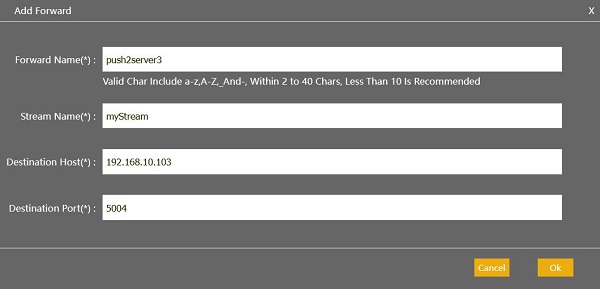- Overview
- License
- Architecture
- System
- Performance
- Install
- Upgrade
- Uninstall
- Release Note
- Web Panel
- Config File
- Process
- Startup
- Shutdown
- Port
- Troubleshooting
- RTMP Push
- SRT Push
- SRT Pull
- UDP Push
- UDP Broadcast
- Source Stream
- Pull Stream
- Playback
- Forward
- SSL
- Snapshot
- UDP packet
- Record & NVR
- VOD
- GB28181
- WebRTC
- API
- Compare to Wowza
When a live stream enters Ti Top Streamer, regardless of whether there are audiences requesting playback, Ti Top Streamer can actively push this live stream to one or more remote destination addresses.
We call it "forward".
Ti Top Streamer support several forward protocols which were introduced as below:
1. rtmp forward
2. MPEG-TS UDP forward
3. SRT forward(Caller Mode)
4、SRT forward(Listener Mode)
Note: Forwarding has nothing to do with how this stream enters the Ti Top Streamer, it simply forwards the existing streams on the Ti Top Streamer.
Introduce them one by one as below:
1. rtmp forward:

Here is a description about these fields:
1) forward name: Just give this forward task a name that is easy to remember,In an Application, do not use duplicate names. For example, Once you plan forwarding to Ali cloud, You can name it "push2Aliyun", so that, Everyone can understand at a glance.
2) Stream Name : Sometimes, We call it stream Id,They mean the same thing, to refer one live stream. This field is to indicate which stream you want to forward out.
3) Destination URL :It is a rtmp url, We will forward live stream to this destination through rtmp protocol.
4) Local host address: In the scenario where the server uses multiple network cards, indicate which network interface to exit from when forwarding? This field is optional and is empty by default, meaning it is automatically assigned by the host routing table.
5) SSL : When forwarding, it is necessary to establish a TCP connection with the other host, This field indicates whether SSL is enabled or not? This field is optional. The default is not to enable SSL.
2. MPEG-TS UDP forward:

Note:Some of the fields have already been introduced earlier and will not be repeated here:
1) Destination Host:The destination host IP address you want to forward also supports domain names.
2) Destination Port:The UDP port number of the destination you want to promote.
3. SRT forward (Caller Mode)

Note: The relevant fields are the same as those introduced earlier, there is no difference, and we will not elaborate further here.
4、SRT forward (Listener Mode)

Note: In case of SRT Listener mode, Because we need to listen to the local UDP port, the listening host and listening port in the above figure are the host address and UDP port of the server running Ti Top Streamer.
In case of SRT Listener mode, the Forwarding is like pull stream, Because it is not actively forwarding, but waiting for other SRT devices to request it.
Here is the URL to pull this SRT stream using VLC player

Here is the playback URL in VLC. You can copy it and replace the IP address and port:
srt://38.101.42.116:10006?mode=caller&latency=50Notes:?mode=caller&latency=50 can be omitted.
